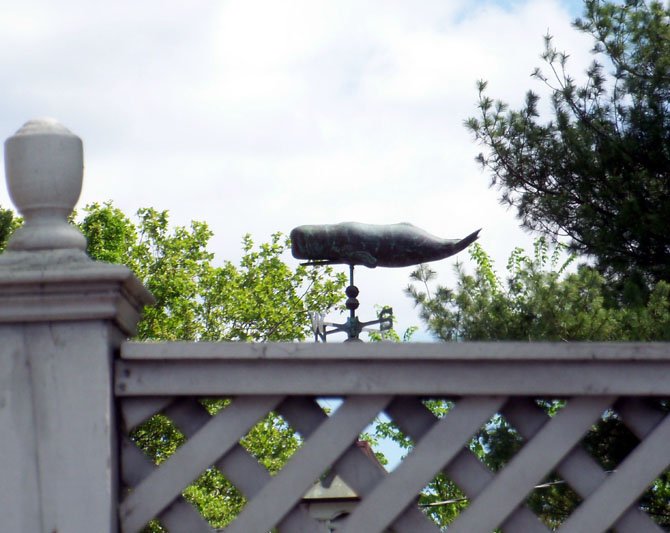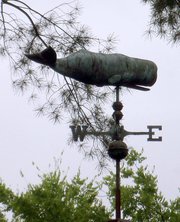Alexandria — King Street slopes down a shallow hill and ends at the flats of an ancient river plain, close by Alexandria's railroad station. Many drivers pausing in traffic will gaze to the right at the landscaped grounds of the National Masonic Memorial, with its geometry of cultivated shrubs and flowers. Few glance to the left over the high white fence topped with wooden latticework. Those who do blink in surprise at "The Whale."
The peak of a small shed is capped with a weathervane featuring The Whale. Closer inspection tells it is a Sperm Whale (Physeter macrocephalus) — like Moby-Dick. In New England, such a feature would draw scant attention since whaling played an important economic, and also romantic literary, role in that corner of the country. But for Alexandria in Virginia, The Whale seems out-of-place.
Mind idling in unison with the halted automobile, wonder sets in. Is the homeowner a relocated New Englander? Has Ancestry.com revealed a great, or great-great, grandfather who was a whaling man? Is the man- or woman-of-the-house an artist one day inspired by a story of the sea?
In contrast to these imaginative wanderings, the facts are simple.
Land records in the courthouse say K. Doherty and P. Scolese are today's owners of 106 West Cedar St. They also are its residents. Inquiry about The Whale caught them in friendly spirits and a quick response ensued. "The [W]hale was there when we purchased the house and [we] didn’t bother to ask the previous owners about it.”
According to those same records, the previous owners were Peter F. and Nancy R. Nostrand. Sleuthing found them at home in Lorton, Va. Nancy Nostrand spoke on the telephone and promptly dashed all hopes of an exotic story. For herself, and for the family in generations past, every connection with whales and whaling was denied. “We found the weathervane in an antique shop in Essex, Connecticut,” she explained. “It caught our eye, so we bought it.”
Essex, Connecticut was not a whaling port. However, as happenstance provides, its namesake whaling ship out of Nantucket inspired Moby-Dick. During 1820, Essex sailed into the Pacific Ocean. West of South America by 1000 miles, a sperm whale rammed and sank her. The following year, survivor and First Mate Owen Chase published the story. Familiar with that account, Herman Melville finished his novel in 1851. (See “In the Heart of the Sea,” by Nathaniel Philbrick, for the full story of the Essex.)
The whaler Essex. A sperm whale crushing the bow. An antique shop in Essex, Connecticut. The sperm whale weathervane. Threads of connection are hinted at, but no real connection exists. All the pieces merely form the product of idle gazing from an idling automobile at the bottom of the hill in King Street.

